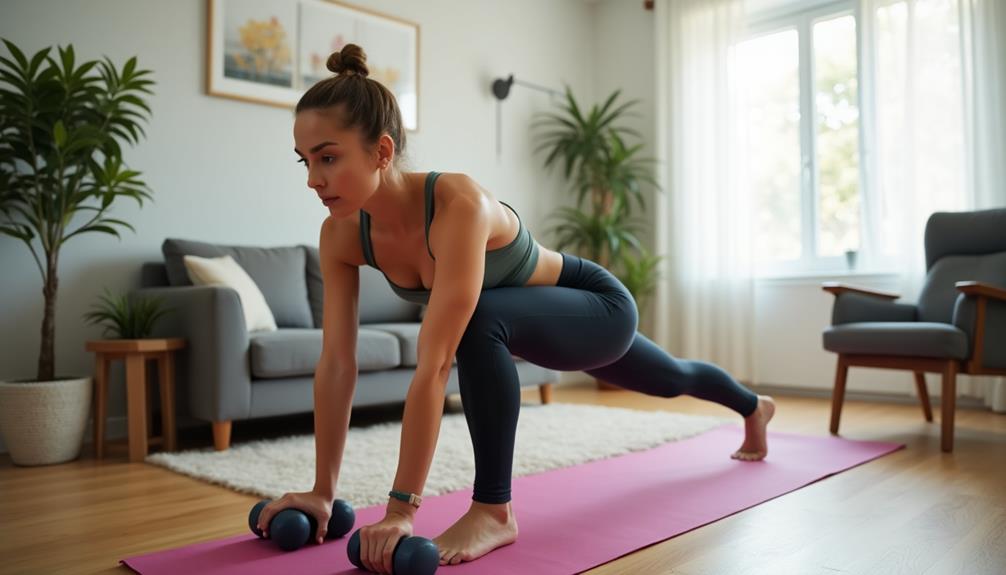Mastering a full-body resistance workout at home can be both effective and enjoyable. Start by gathering necessary equipment, like resistance bands and dumbbells, to target various muscle groups. Incorporate bodyweight exercises such as push-ups, squats, and lunges for a balanced routine. Structure your workouts by setting specific goals and adhering to a consistent schedule, ideally 3-5 times a week. Don't skip warm-ups; they're essential for preventing injuries. Finally, stay motivated by tracking progress and joining online fitness communities. These steps will help elevate your home workouts, and there's much more to discover about optimizing your routines.
Core Insights
- Utilize essential equipment like resistance bands and dumbbells for versatile strength training targeting various muscle groups effectively.
- Incorporate bodyweight exercises such as squats, push-ups, and planks for a balanced full-body workout routine.
- Structure your workout schedule with 3-5 sessions weekly, focusing on major muscle groups for optimal results.
- Start each session with warm-up and mobility exercises to prevent injuries and enhance performance.
- Set specific fitness goals and track your progress to maintain motivation and accountability throughout your training.
Benefits of Resistance Training

Resistance training offers a multitude of benefits that can transform your fitness journey. First, it helps build muscle strength, making daily tasks easier and more manageable. You'll notice improved posture and stability, reducing your risk of injury. With the right resistance band set, you can achieve a full-body workout at home, targeting various muscle groups effectively. These versatile tools come in different importance levels, allowing you to progress as you get stronger.
Additionally, engaging in resistance training boosts your metabolism, allowing you to burn more calories even at rest. This can support weight management and fat loss goals. You'll also experience enhanced bone density, which is essential for long-term health, particularly as you age.
Moreover, resistance training has mental benefits, too. It can elevate your mood and reduce stress, making you feel more energetic and focused. Incorporating this type of training into your routine can lead to a healthier, more balanced lifestyle overall.
Essential Equipment for Home Workouts
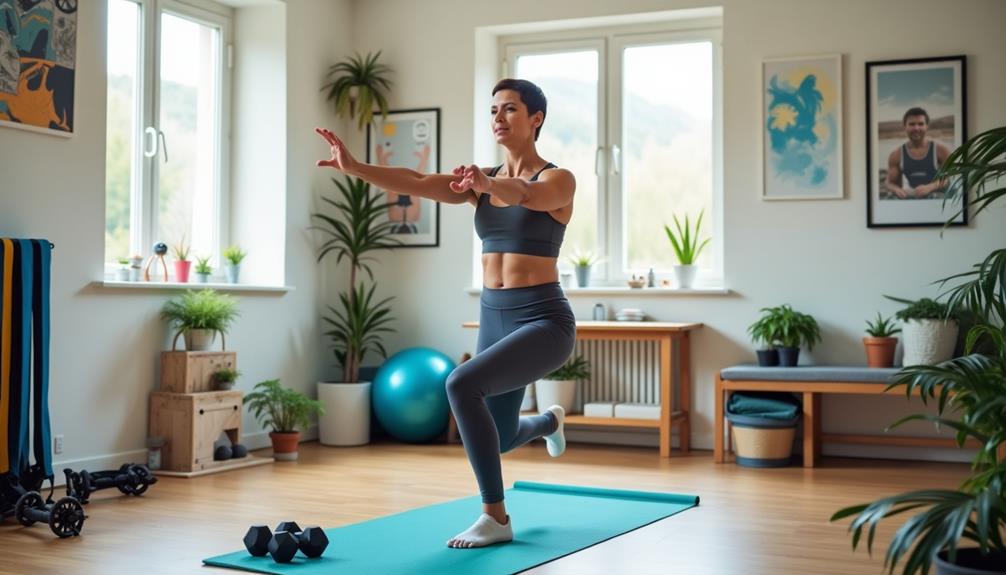
To effectively create a full-body workout at home, having the right equipment is crucial for maximizing your results. Start with resistance bands; they're versatile and perfect for strength training. Dumbbells are another great option, allowing for a range of exercises targeting different muscle groups. Adjustable dumbbells are particularly useful for home workouts, as they offer a wide range of weight options without taking up much space. If you have space, consider a stability ball for core workouts and balance training. A yoga mat can provide comfort during floor exercises and stretching routines. Finally, don't underestimate the power of a sturdy chair or bench for completing various movements safely. With this essential equipment, you can efficiently tailor your workouts to meet your goals and guarantee you're engaging all major muscle groups for a balanced routine.
Bodyweight Exercises to Include
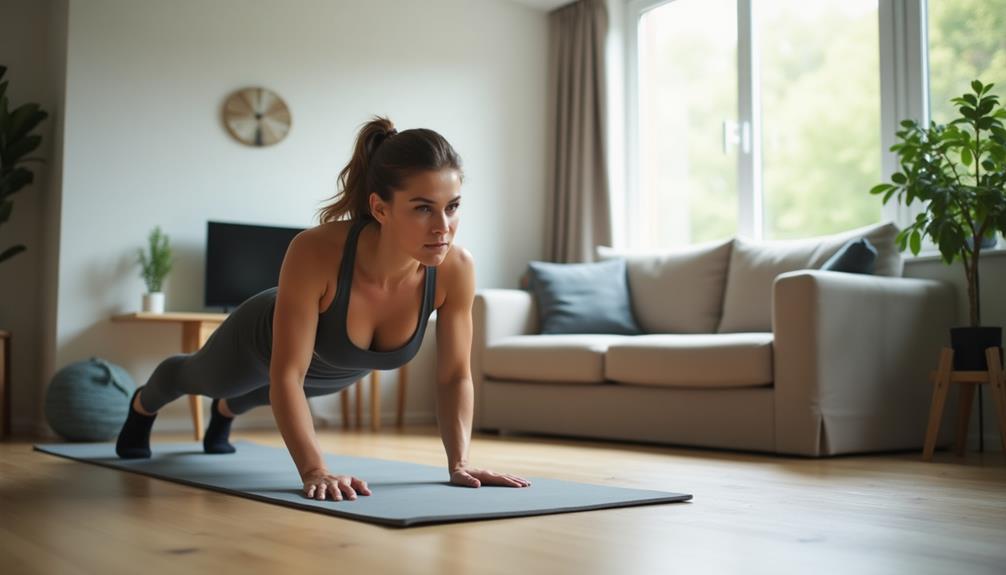
Having the right equipment sets the stage for an effective workout, but you can achieve a full-body routine using just your body weight. While resistance tubes offer various resistance levels for different fitness goals, bodyweight exercises provide a great foundation. Here are some key exercises to include:
Push-Ups
These target your chest, shoulders, and triceps. Modify them by performing knee push-ups if needed.
Squats
Squats engage your quads, hamstrings, and glutes. Keep your feet shoulder-width apart and lower your hips as if sitting in a chair.
Lunges
Lunges work your legs and improve balance. Step forward with one leg, lowering your hips until both knees are bent at about 90 degrees.
Planks
Planks strengthen your core. Hold your body in a straight line from head to heels, resting on your forearms and toes.
Incorporating these exercises will give you a balanced full-body workout.
Structuring Your Workout Routine

Creating a well-structured workout routine is essential for maximizing your results and keeping your motivation high. Start by determining your fitness goals. Do you want to build strength, improve endurance, or increase flexibility?
Next, plan your weekly schedule. Aim for three to five workout sessions, allowing for rest days in between. Each session should include a mix of exercises targeting major muscle groups, like squats, push-ups, and lunges.
Consider the duration of your workouts. Aim for 30 to 60 minutes, depending on your fitness level.
Warm-Up and Mobility Exercises
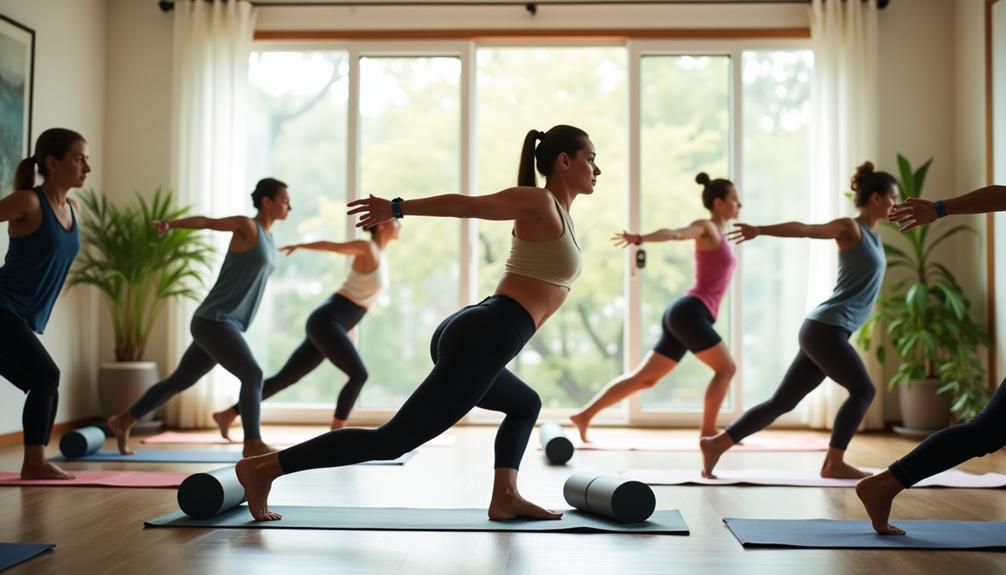
Before diving into your workout, it's crucial to include warm-up and mobility exercises that prepare your body for the demands ahead. These exercises boost blood circulation to your muscles and enhance your range of motion. Start with dynamic stretches, like arm circles and leg swings, to loosen up your joints. Aim for about five to ten minutes of movement to raise your heart rate.
Incorporate mobility drills, such as hip openers and torso twists, to enhance flexibility and stability. Focus on areas that you'll engage during your workout, ensuring you're fully prepared. Remember, a proper warm-up can help prevent injuries and improve your performance, so don't skip this vital step. With your body ready, you'll be all set for a successful workout session.
Targeting Major Muscle Groups

With your body warmed up and ready, it's time to focus on targeting major muscle groups for a balanced full-body workout. Start with your legs. Squats engage your quads, hamstrings, and glutes. Next, shift to your upper body. Push-ups work your chest, shoulders, and triceps. For your back, consider bent-over rows, which target your lats and rhomboids. Don't forget your core; planks are excellent for stability and strength.
Aim for 8-12 repetitions for each exercise, adjusting based on your fitness level. You can perform these movements in a circuit to maximize efficiency. Remember, focusing on all major muscle groups helps you build strength evenly, enhancing your overall fitness and preventing imbalances.
Tips for Maintaining Proper Form
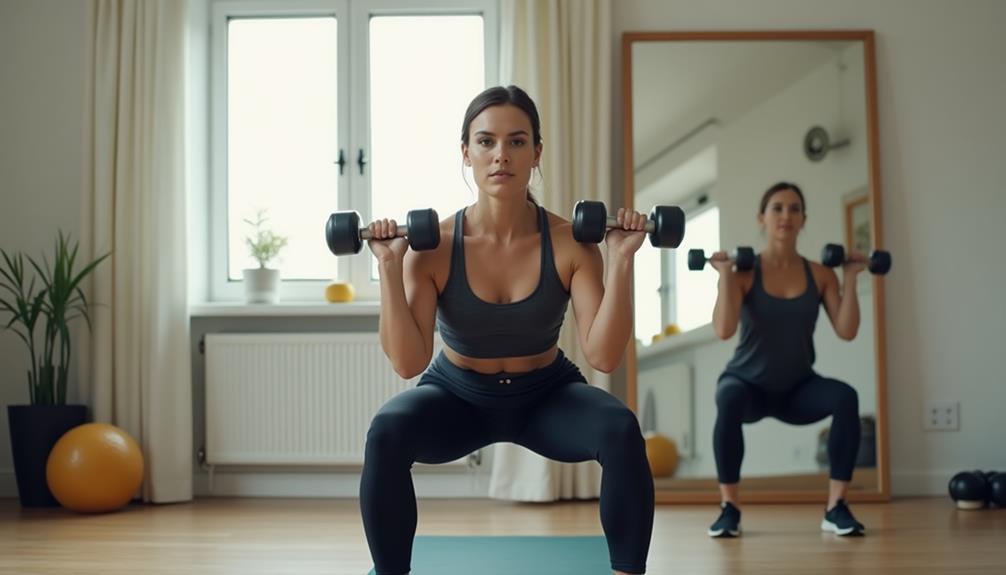
Maintaining proper form is crucial to getting the most out of your full-body resistance workout and avoiding injuries. When you focus on your form, you verify that you're engaging the right muscles and reducing the risk of strain. Here are some tips to help you maintain proper form:
- Engage Your Core: Keep your core tight throughout each exercise to stabilize your body and protect your back.
- Use a Mirror: If possible, exercise in front of a mirror to visually check your alignment and posture.
- Start Slow: Begin with lighter weights and concentrate on technique before increasing weight or intensity.
- Listen to Your Body: If something feels off or painful, stop and reassess your form or take a break.
Cool Down and Stretching Techniques
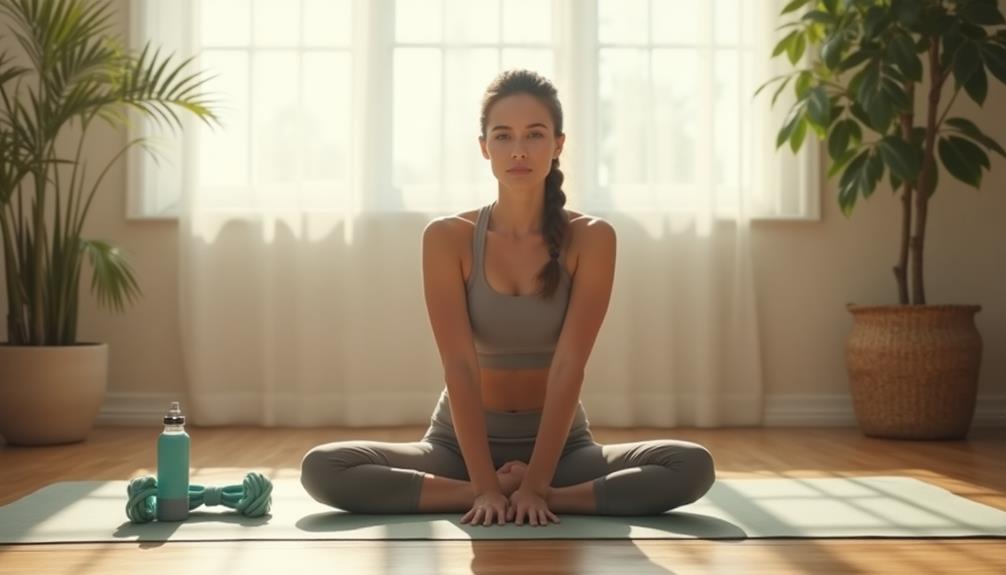
Cooling down and stretching after your full-body resistance workout is essential for recovery and flexibility. These practices help reduce muscle soreness and improve your overall range of motion.
Here's a quick reference table to guide your cooldown routine:
| Stretch Type | Duration | Benefits |
|---|---|---|
| Forward Bend | 30 secs | Stretches hamstrings and back |
| Chest Opener | 30 secs | Expands chest and shoulders |
| Seated Twist | 30 secs | Enhances spinal flexibility |
| Quad Stretch | 30 secs | Targets quadriceps and hips |
| Child's Pose | 1 min | Relaxes the back and neck |
Incorporate these stretches into your routine to enhance your recovery process effectively. You'll feel more refreshed and ready for your next workout!
Creating a Progressive Plan
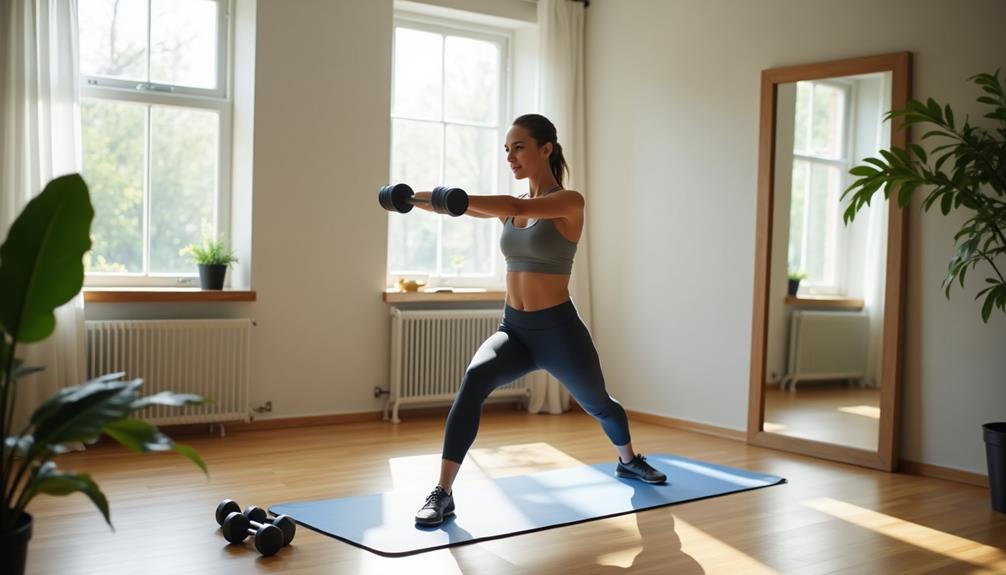
Creating a progressive workout plan is essential for continually challenging your body and achieving your fitness goals. To [GUARANTEE] steady improvement, follow these steps:
- Set Clear Goals: Define what you want to achieve, whether it's strength gain, muscle toning, or endurance.
- Increase Intensity: Gradually add resistance, increase repetitions, or shorten rest periods to push your limits.
- Vary Your Exercises: Incorporate different movements and modalities to target various muscle groups and prevent plateaus.
- Track Your Progress: Keep a workout log to monitor your achievements and adjust your plan as needed.
Staying Motivated at Home
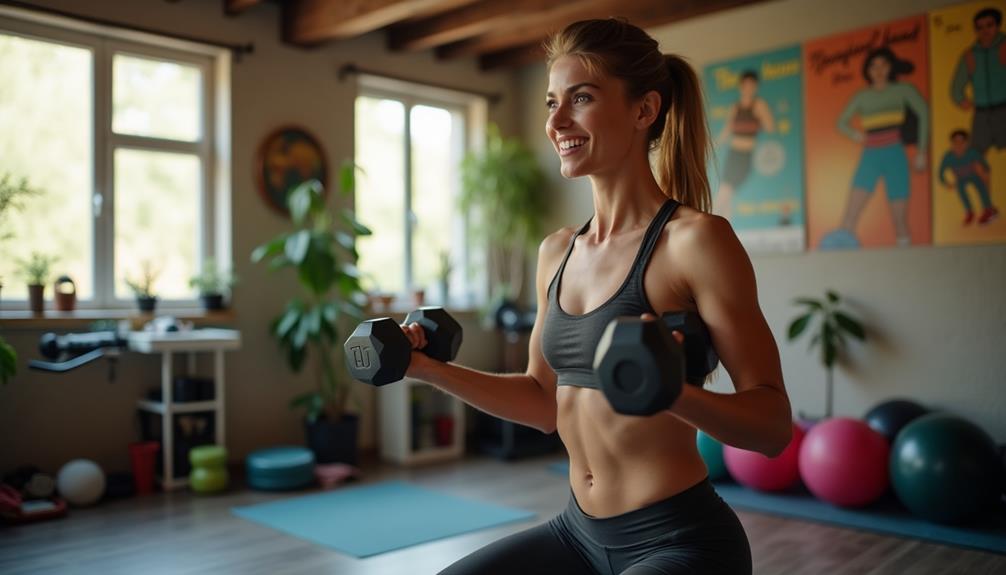
As you work on your progressive workout plan, staying motivated at home can be a challenge. To keep your drive alive, set specific goals. Break larger objectives into smaller, achievable milestones. Celebrate each success; it'll boost your morale.
Create a dedicated workout space. A distinct area can help signal to your brain that it's time to focus. Incorporate variety into your routine. Changing exercises, timing, or equipment can keep things fresh and exciting.
Join online fitness communities. Engaging with others can provide support and accountability. Finally, schedule your workouts like appointments. Consistency helps create a habit. By implementing these strategies, you'll find it easier to stay motivated and committed to your fitness journey at home.
Frequently Asked Questions
How Often Should I Do Full-Body Resistance Workouts at Home?
You could hit the gym every day or opt for just a couple of sessions weekly. Ideally, aim for two to three full-body resistance workouts weekly, allowing your muscles to recover and grow stronger effectively.
Can I Combine Resistance Training With Cardio Workouts?
Absolutely, you can combine resistance training with cardio workouts! Just alternate between them in your routine. This mix boosts your endurance and strength, keeps workouts interesting, and helps you achieve your fitness goals more effectively.
What Should I Eat Before and After My Workouts?
Before your workouts, grab a light snack with carbs and protein, like a banana with peanut butter. Afterward, focus on a balanced meal with protein, healthy fats, and complex carbs to fuel recovery and growth.
How Do I Track My Progress Over Time?
To track your progress over time, keep a workout journal. Note your exercises, sets, and reps. Take regular photos and measurements. Review your achievements weekly to stay motivated and adjust your goals as needed.
Are There Any Common Mistakes to Avoid in Resistance Training?
When you're resistance training, avoid rushing through exercises, neglecting proper form, and skipping warm-ups. Don't push too hard too soon, and make certain you balance muscle groups to prevent injury and guarantee effective progress.

